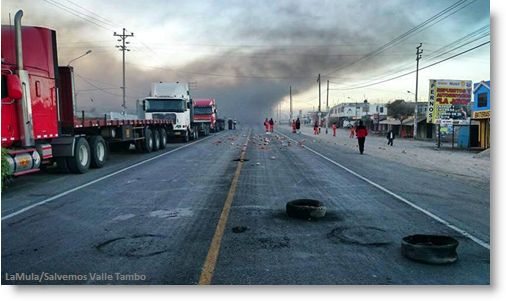
Presidential candidate Pedro Pablo Kuczynski is calling for a 60-day “pause” in the Arequipa conflict, while the government seeks solutions to the region’s rejection of the Tia Maria copper project.
Seven police were injured yesterday and one civilian detained, during violent protests on the first day of a 72-hour regional strike called in Arequipa against both the government and Southern Copper’s Tia Maria project.
A civilian also died, of a heart attack as he was travelling by bus between Camaná and the city of Arequipa. His brother, director of the Islay health network, said Eloy Vera, 60, suffered a shock due to the violence used by protestors to block the Pan American highway and prevent the bus and other vehicles from continuing their journey.
“The central government has to have a social investment plan so that the population can trust the State,” Kuczynski said, suggesting investment in social impact infrasatructure such as drinking water, roads, hospitals, schools and electricity grids, “that must come before any large project.”
Schools were closed again this week, and the government has ordered a military contingent to remain in the Islay province for a week beyond the original schedule of June 7.
In the meantime, the Finance Ministry has placed an embargo on the bank accounts of four municipal governments —Islay, Punta del Bombón, Dean Valdivia and Cocachacra — at the request of the Comptroller General to prevent misuse of funds to back the protests.
This followed a statement made by environmental lawyer Jesus Gomez in Arequipa, working with Southern Copper, saying that he taped a conversation with the president of the Valle del Tambo Defense Front, Pepe Julio Gutierrez, in which the latter said that if they came to an agreement “the lentils must be in cash.”
President Ollanta Humala on Saturday authorized the military to intervene in the southern province of Islay, to help police restore order after struggling to contain increasingly violent protests that resurged in April against the large Tia Maria project in the mountains above the Tambo Valley. Defense Minister Jakke Valakivi told state news agency Andina that some 2,000 soldiers were being sent.
The Interior Ministry, which oversees the National Police, issued a press release saying that the police were responsible for ensuring order, and that the Armed Forces would support the police by guarding strategic sites, preventing damage to public services and ensuring highways are not blocked. In a statement the Ministry said the decision to bring in the military did not constitute a State of Emergency.
The move is a major escalation of the conflict, which had already resulted in the deaths of two protesters and one police officer, and several police seriously injured. The police officer was confirmed dead on Saturday, from severe injuries during clashes with protesters in earlier days.
“We can’t tolerate this situation any more,” said Justice Minister Gustavo Adrianzen. “His death won’t be forgotten.”
The protests have been going on since March 23 when residents in Islay took to the streets to oppose Southern Copper’s $1.4 billion Tia Maria mine. The government has already approved the project’s revised environmental impact study — in 2009, UNOPS made 138 observations to the initial study— but local mayors and farmers in Islay want the project to be canceled over its environmental impact in the agricultural Tambo valley.
Originally the concerns were over its impact on the water supply. In response, Southern Copper said it would desalinate water from the Pacific Ocean for its operation. However, residents remain steadfast in their opposition over other issues, including air and soil contamination of farmer’s crops.
According to political analyst Nicolas Lynch, during a debate on Canal N with business consultant Pablo Bustamante, four main issues concern the farmers of which oneis that the open pit mine will will be about 1.5km and 1km deep, digging into the water table on which the Tambo valley depends.
Successive Peruvian governments have struggled with social conflicts in the country’s vast natural resource sectors.
In 2009, over 30 people were killed, including more than two dozen police officers, during clashes in a remote jungle region of Bagua over former President Alan Garcia’s plans to open up the Amazon rainforest to private investors.
President Humala’s political agenda was hijacked in 2011, shortly after taking office, by large rallies against the massive Minas Conga copper-gold project. That project was eventually put on the back burner after months of protests that resulted in deaths.
Humala’s government is now determined to prevent Tia Maria from following the same path as Minas Conga. Canceling another mine project would have a major impact on the investment climate in Peru as the government is trying to revitalize a once red-hot economy with stimulus packages.
Peru is a top global producer of copper, gold, silver, zinc and lead. The minerals account for about half of its total exports.






Peruvians fighting with other Peruvians over a mining project that will make a foreign corporation even more wealthy. Just doesn’t seem right.